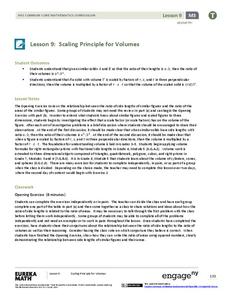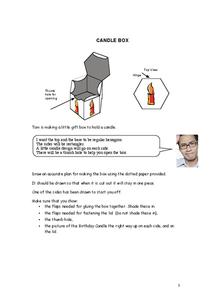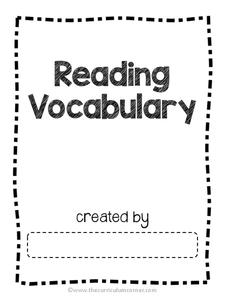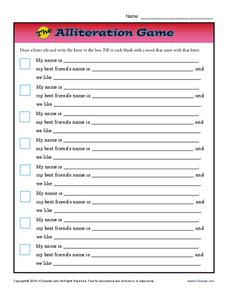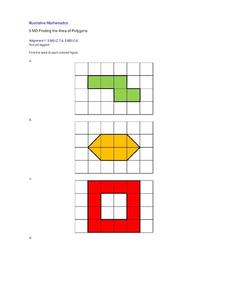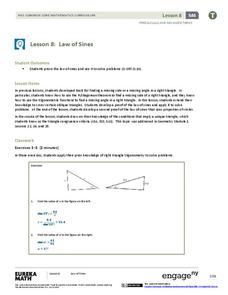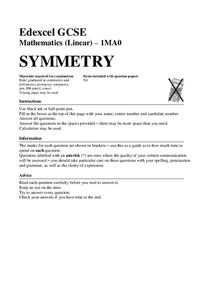EngageNY
Scaling Principle for Volumes
Review the principles of scaling areas and draws a comparison to scaling volumes with a third dimensional measurement. The exercises continue with what happens to the volume if the dimensions are not multiplied by the same...
Inside Mathematics
Quadrilaterals
What figure is formed by connecting the midpoints of the sides of a quadrilateral? The geometry assessment task has class members work through the process of determining the figure inscribed in a quadrilateral. Pupils use geometric...
Centre for Innovation in Mamatics Teaching
Area, Perimeter and Volume
Develop young mathematicians' knowledge of two- and three-dimensional shapes with this geometry workbook. From learning about the classifications of different shapes and figures to calculating their area, perimeter, and volume, this...
Mathematics Assessment Project
Candle Box
Individuals draw a net for a hexagonal pyramid — with some stipulations. The net must contain the printed images so they appear correctly on the box, along with tabs to glue the box together.
World Wildlife Fund
Arctic Shapes
In a two-part worksheet, young geometers examine 3-D shapes and describe their attributes in a table. They will be able to draw the shape and name the number of vertices, faces, and edges. In the second part, individuals explore...
Curriculum Corner
Academic Reading Vocabulary
From A to Z, learners define, draw, and find examples of specific reading focus skills in an alphabetized reading vocabulary packet. Words include dialogue, theme, text structure, genre, paraphrase, and many more.
Curated OER
Three Dimensional Figures
In this geometry worksheet, students study diagrams with labels of common geometric figures. Students then answer 24 questions. Then they draw and label their own figures.
Curated OER
Pattern Recognition
In this pattern recognition activity, students determine which shape comes next in nine strips of shapes and then draw that shape on the line provided.
Curated OER
Recognize and Draw Shapes Word Problems
It's time for a geometry warm up! Geometry scholars examine a figure to determine its name from a list of four choices. The figure, a trapezoid, is large enough for the whole class to see if you were to project this. An explanation at...
Common Core Sheets
Finding Area by Tiling
Third graders find area by tiling a rectangle based on the given side lengths. This helps learners visualize and create the area of a figure. From here, they can count the total number of tiles inside the rectangle to find the answer.
02 x 02 Worksheets
Symmetry
Get learners' minds rotating and reflecting while looking for symmetry. Pupils investigate figures to determine the number of lines of symmetry and if the figure has rotational symmetry. Classmates work together in groups to find out the...
K12 Reader
Alliteration Game
Practice alliteration with a fun game! Kids match names to a best friend's name, and add something they both like.
Lincoln Public Schools
Developmental Strokes: Pre-Writing Worksheet
Young writers develop their fine motor skills one stroke at a time with this simple tracing worksheet. Looking at pictures of eight basic figures ranging from horizontal and vertical lines to circles and triangles, children practice...
Curated OER
Finding the Area of Polygons
Third graders are exposed to finding the area of polygons by decomposing figures and recomposing them into rectangles. This strategy allows children to expand on their prior knowledge of constructing shapes by rearranging parts into...
EngageNY
Law of Sines
Prove the Law of Sines two ways. The ninth segment in a series of 16 introduces the Law of Sines to help the class find lengths of sides in oblique triangles. Pupils develop a proof of the Law of Sines by drawing an altitude and a second...
Mathed Up!
Symmetry
Eleven problems provide pupils the opportunity to find the lines of symmetry or identify rotational symmetry. Scholars alter designs to make them symmetrical, learn to recognize signs that are symmetrical, and identify the type of...
Code.org
Functions and Top-Down Design
Let me break it down for you! Introduce your class to a way of breaking up a complicated task into its component pieces. Individuals draw a complex figure using JavaScript and then break it down to help determine the...
Charleston School District
3D Applications of the Pythagorean Theorem
How many right triangles can you find in a prism, cone, or pyramid? Using right triangles to find lengths in three-dimensional figures is the focus of the lesson. After working with the Pythagorean Theorem to find missing side...
Curated OER
Symmetry Worksheet
This resource offers a series of hands-on activities in which learners sketch and construct symmetrical origami, paper dolls, snowflakes, and polyhedra while adhering to specific requirements. These activities ask class members to...
Noyce Foundation
Cubism
If cubism were a religion, would you follow it? Lower-level tasks focus primarily on counting the number cubes in a structure and relating the number to surface area. As learners progress to higher-level tasks, isometric drawings and...
Have Fun Teaching
Inferences (2)
Encourage young readers to use their prior knowledge, as well as text clues, to draw inferences from text. Provide them with this worksheet that asks them to record a passage, the background information they already have, the text clues...
Los Angeles County Office of Education
Assessment for the California Mathematics Standards Grade 2
Test scholars mathematic skills with an assessment addressing addition, subtraction, multiplication, place value, measurement, geometric shapes, expanded notation; and their ability to compare numbers, write number...
Curated OER
Segment Exercises
In this segments worksheet, learners draw a figure for each problem where line segments intersect at a certain point and label each line and intersection. Students complete 3 problems total.
Curated OER
Monkeying Around with Junie B.
Junie B. Jones is the star of this worksheet. Learners draw a picture of what she thought her brother looked like in Junie B. Jones and a Little Monkey Business. They draw another example of figurative language.
